 |
Yukiko SHIKATA NewFUNction of Technology | Emerging Media Art from Japan |
||
| Conférence mercredi 5 mars 2003rence du mercredi 5 mars 2003 |
|
||
| Yukiko |
|
||
| Yukiko | NewFUNction of Technology | Emerging Media Art from Japan 1. INTRODUCTION [a] Basic Structure of Japanese Cultural Situation _HYBRID-MONO-CULTURE Japanese culture is regarded as a "mono" culture with less differentiation, less confrontation with "others" geographically and culturally. (Here "others" means not only "people" but also "nature"). But, by the historical revisionism especially since 90s made "Japan" to be understood as a hybrid cultural node which has historically processed diverse culture via the sea to generate "Japanese", rather as Japan the united "mono" entity. _MICROPERSPECTIVES Originally no grand plan or overview, no linear perspective in time and space, in society and city. In Europe, there were overview and macro-perspective, as the people always confronted to "others", and analyzed to include them in their map/world. _INTERSUBJECTIVITY Less notion of "self " "identity" (as these notions appear in relation to the "others"). Ambiguity: less discussion (and less logical, structural approach). The word "identity” was not originally existed in Japanese language. _COMPACT BODY Small, Compact, Neutral (asexual), Sensitive, and behavior follows the physicality. _METABOLIC WORLD Nature, society based in "change" "transition", no static perspective. [b] Japanese Situation after mid 90s: _PHENOMENON Party is Over, break down of the bubble-economy of 80s, disclosing hidden aspects in the society: security and safety in question. The symbolic and influential accidents in mid 90s: Kobe-Awaji Earthquake (January 1995), Sarin dissemination by Aum religious cult (March 1995). _RESULT End of existed system (social structure) = facing to the dysfunction. A potential to rethink the social, cultural situation, shift to the autonomous movements (volunteer, NPO, NGO..), being independent and building relations. _CULTURE >Diverse Daily Culture (information overload): manga, anime, game.. >Tech+Body: tech gadgets everywhere(game boy, pager, mobile phone…), High-tech fetish, extension of body(artificiality+ nature connected). >Connected Identity (to the cyber world, communication via interface) >Info-Remix (quick to come and go), various culture from abroad were collected, accumulated, appropriated, adapted into the new creation. >"Virtuality Bites": virtual gets back to real. Physical movements influenced by virtual games and animation. Particular example is new hybrid physical fighting games such as "K1" "Pride" (transgenre, any style such as Karate, Judo, Boxing and wrestling, etc.) appeared in mid 90s. [c] New Generation of Media Art _BACKGROUND >Game Generation: grown up with mass-media & culture and tech-abundancy >Social Change: unstable time, time of transition when they were about 20-year-old or younger. >Media Art and Literacy Education: SFC (Shonan Fujisawa Campus of Keio Univ. since 1990), IAMAS (International Academy of Media Art and Science, Ogaki since early 90s). Also some artists came out independently beyond fields: design, sound, architecture, etc. >Media Art Organizations: NTT InterCommunication Center (since 1990), Canon ARTLAB (1990-2001, where I worked as co-curator), ARTEC (Art&Technology Biennale in Nagoya, 1989-mid90s). _TWO DRIVING FORCES FOR THE NEW EXPRESSION >Street Culture & Hacking & DIY Spirit: Hip-hop, graffiti, skate board, DJ & VJ …hacking the city, existing works (sampling, remix, for the new creation). >Internet for new expression: extension of street, new public space: changing communication, changing society and expression, crossing borders, shared culture |
||
2. INTRODUCING ARTISTS [a] exonemo (http://www.exonemo.com/) Net art duo consisted of Yae Akaiwa and Kensuke Sembo. Experimental projects on since 1996 by using the anonymity, process-oriented, real-timeness of the Net. They play with the net wildly as games or scratch DJ, and they share the global net and DIY culture by their wit and critical viewpoint. "DISCODER" (1999) enables the user to quickly destroy the compatibility of the HTML code that forms surfaces on the Web by tapping keys on the keyboard. The keyboard becomes a weapon and the struck letters invade the HTML code like bugs. In "DISCODER" (Installation version) (2000), a large number of mouses are connected to the keyboard and scattered all over the floor, forcing the user to crawl around the floor to operate them. The operator is manipulated, and the result is confusion. Their works evoke the primal human desire, at the same time, they make us face ourselves objectively, revealing the fragility concealed in IT society. Since 2000 exonemo’s work has expanded into a variety of new media, including installations and software, works in "i-mode" (the information system associated with NTT DoCoMo cellular phone, and live performances), etc. The software "FMS (FragMetal Storm)"(2000) and “FMS02”(2002) takes web sites all over the world as a huge info-resource, as a metaphor for the brain, and collages the images and texts of sites searched by a key word in real time. In the installation version, words was taken from Café via a microphone, sent to the voice recognition system, and the words were sent to “FMS”, and the results were shown as realtime remix of image and text on the projection screen. Here, misrecognition/error have often generated the unexpected result(strange word to be searched). “FMS” promotes the automatic remix for the poetical interventions, and which is connected to the tradition of experimental poetry such as in Mallarme, Dadaism, etc. exonemo also produced the sound remix software "HIGH BALL" (2002), a gnutella-crone software to search & cut-up MP3 files randomly. By typing the keyword(as FMS), the use get the automatic remix of sounds came out realtime of Gnutella Network. In "RGB Flicker" (2003), the latest work from them, the user can open the windows at any place at any size, and change the RGB rates and flickering speed. The user can watch the screen directly to enjoy or get addicted, or use it as an ambient interior light in bed room(!). The flickering lights would generate "moiré" perceptually on the user’s retina, also it reminds us of "Pokemon phenomenon" - the "Photoinduced-epileptic attack" happened in December 1997 in Japan for some hundreds of school children watching "Pocket Monster" TV animation series. But, apart from that case, here with "RGB Flicker" it is the user’s own responsibility to get the same attack or get addicted, where the "danger" and "beauty" is two sides of one coin. The use of the work depends strongly on each user. Constructing the shapes and playing with them also function as a therapy method, where the results show the "mental scape" of each user. The user can also share his/her own flicker with others by submitting it. |
|||
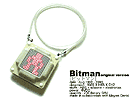 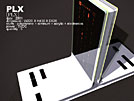 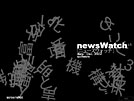 Products (5) (14) (18) of Kuwakubo |
[ b] Ryota Kuwakubo: www.vector-scan.com Kuwakubo calls himself "Device artist"– he produces his own game-like "media" or "products" by his hands beyond digital and analog for the people to play with. They are well-designed(retro-future modern or like "sony-style"), looks low-tech with simple interface, and attracting the people by its unique- and friendliness. The works trigger users’communication by creating a shared environments, and raise the question of the meaning of communication(as they have meta-frame). One of his main products is a "Bitman" (1998-99, collaboration with Maywa Denki), a small tool that the user can create a 20 x 20 pixel animation. It was further developed for mass-product and available in stores. In the "BitHike", a similar project on the web that the user can make and share the 8 x 8 pixel x 8 frame-animation(the work also has the table-game version). "PLX" (2001) is a game machine with which two users, facing each other to the screen between them, play different games. The position of moving icon is the same, but the icon and the story is totally different. They face each other, looks playing the same game, but actually not. Kuwakubo had this idea from the daily situation, such as: after talking quite a while, we suddenly notice that we had been talking on totally different topics. In such a situation, we thought communication went smooth, until the gap was revealed between us. The work deals with the ambiguity of communication, asking the boundaries of "communication" and "discommunication", "understanding" and "misunderstanding". The work make us face that the world is perceived, defined by each, and we don’t share the same world and on that the "communication" stands. "NewsWatch" (2002) is the software automatically connects to the search engine, taking letters from the new site, fragmentaly floating by changing position. The work has the Japanese letter version (each Chinese character has meaning), and English version (alphabet=no meaning). The letters from the same word (such as "france") floats close each other on the screen, so the audience might recognize the word by carefully watching them for a while. By processsing the letters from current news topics(mass journalism), fragmenting them like a experimental poetry, "NewsWatch" quietly criticizes the existing media and information systems. The last work I introduce from Kuwakubo is the video documentation of "OPEN MIND live event" (December, 2002) I organized, where Kuwakubo made the original software for his first live. The work is a kind of game software to set up the character and position of virtual objects, and sound generates accordingly. For making this work Kuwakubo made an intensive historical research of the game sound and used the sampled sounds of existing games. This episode tells a lot about his strong aspect of "Otaku" - and craftsman- ship products of Ryota Kuwakubo. |
||
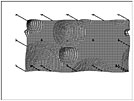  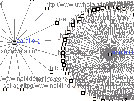 |
[c] doubleNegatives : http://www.doublenegatives.jp/ dN, launched by architect Sota Ichikawa in 1998 has been investigating the original notion of "Architecture" beyond physical or non-physical/informational. Led by Ichikawa, dN changes the team members depending on the projects, but continuously researching the new way of "notation", apart from the Cartesian coordinates, by setting up "Polar coordinates" which sets the "Zero" position in the personal/human body. They raise a fundamental question how to see and capture the space and the world and make us experience the new notations through their works. "dqpb(dynamic quadruple phonic building) #2" (2000) is a permanent 3D interactive sound installation at Kankaku museum of Iwadeyama-cho, Japan. In this work, the participant can operate 3D sound object by using a ring-shaped interface in a dark space. The person can turn the handle (by pulling wire) up, down, right, left... to all directions. The length of the wire defines the distance between the virtual sphere sound object (about 40m radius). When the participant pulls the wire, the sound object comes closer, when loosen, farther. Sound object (virtual) flies inside invisible dynamic phonic building. The work is for two participants, two sound objects would be mixed and interfare each other realtime, creating a complex dynamic phonic environment. "plaNet Former" (2002), be operated online, utilizes the link structure of the web pages as resource, not the contents. The work forms planet-like sphere by following the links of web page, by using the "Former Agent(FA)" (the intellectual agent to form "plaNet", by taking a URL, read the link from html, memorizes it and judges route). The user can type out any URL, then FA start to form the planet. Up to 10 FA can work parallel, which means the user can type out 10 URLs to start with. The user can set up the size of the planet, and percentage of the link occupation (link density of the planet) , and when the first "plaNet" is filled with full of links, the work starts to form a new planet. FA has learning ability so when FA reaches to the dead link, it goes back the route according to the past memory and find another links to go on. Then just wait,.. FA looks like a living creature to keep investigating the links in the Internet. The work is based on the current broadband situation, and the user is expected to take time, to let the agents move around continuously to see the ongoing, open-end process. The work continues autonomously, without any fixed purposes or destination, beyond the user’s expectation, which could be said a kind of “living architecture”. "ResourceHanger+" (2002), an online work, is based on the idea of using existing web sites as resources. The user can input any URLs of existing web sites to make the hybrid of them. It supports basic cycles of all creative act such as: copy -> improvement -> copy -> ... as the process will be further repeated. The code by JAVA for this work is also open for further improvement. |
||
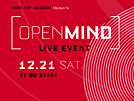 * The live of Ryota Kuwakubo and portable[k]ommunity shown in the lecture was from "OPEN MIND" live event (Dec.21, 2002 at Roppongi Hills Information Center/THINK ZONE, Tokyo, organized by Mori Art Museum), which featured the artists of "OPEN MIND" CD. |
|
||